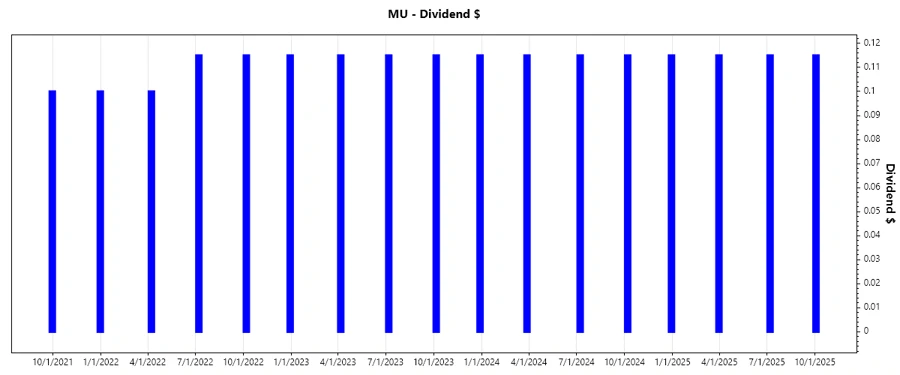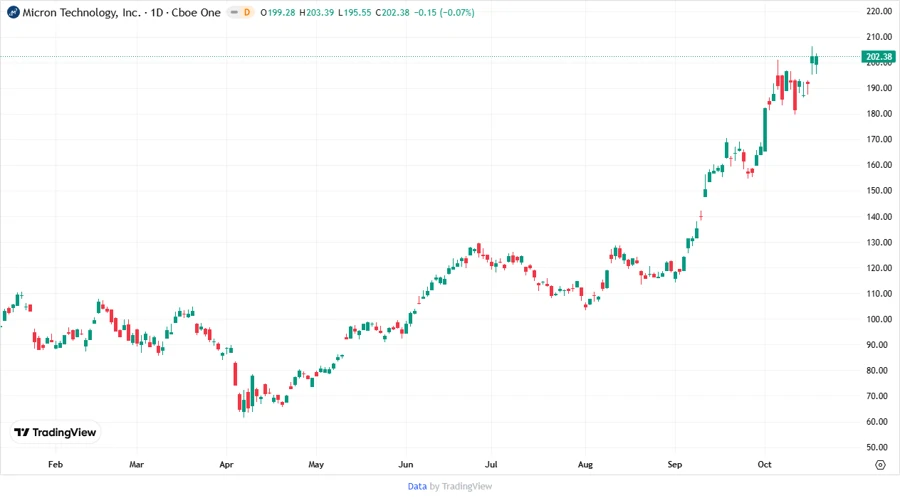October 19, 2025 a 07:46 am




MU: Dividend Analysis - Micron Technology, Inc.

Micron Technology, Inc. (MU) presents an intriguing profile with its modest dividend yield. While its dividend history is stable, recent financial performance indicates some potential challenges. Investors should carefully weigh the impact of market conditions on its future dividend capabilities.
📊 Overview
Micron Technology operates in the technology sector and has established a tradition of steady dividend payments over the past 11 years.
| Metric | Details |
|---|---|
| Sector | Technology |
| Dividend yield | 0.24% |
| Current dividend per share | 0.47 USD |
| Dividend history | 11 years |
| Last cut or suspension | None |
📈 Dividend History
Micron has maintained consistent dividend payments, which highlights its commitment to returning value to shareholders. This track record is significant for long-term income stability.

| Year | Dividend per Share |
|---|---|
| 2025 | 0.345 |
| 2024 | 0.460 |
| 2023 | 0.460 |
| 2022 | 0.445 |
| 2021 | 0.200 |
📊 Dividend Growth
Over the recent years, Micron has shown robust dividend growth, indicating a positive trend in shareholder returns.
| Time | Growth |
|---|---|
| 3 years | 32.00% |
| 5 years | 79.05% |
The average dividend growth is 79.05% over 5 years. This shows moderate but steady dividend growth.

🗣️ Payout Ratio
The payout ratios reflect a conservative approach, with low values indicating a sustainable dividend policy under current earnings and cash flow conditions.
| Key figure | Ratio |
|---|---|
| EPS-based | 6.11% |
| Free cash flow-based | 5.85% |
The EPS payout ratio of 6.11% and FCF payout ratio of 5.85% signify prudent dividend distribution.
💰 Cashflow & Capital Efficiency
Assessing the cash flow yield, earnings yield, and capital efficiency metrics provide insight into Micron's operational performance and its ability to sustain dividends.
| Year | 2025 | 2024 | 2023 |
|---|---|---|---|
| Free Cash Flow Yield | 1.23% | 0.11% | -8.00% |
| Earnings Yield | 6.27% | 0.73% | -7.63% |
| CAPEX to Operating Cash Flow | 49.05% | 98.58% | 492.37% |
| Stock-based Compensation to Revenue | 2.60% | 3.32% | 3.84% |
| Free Cash Flow / Operating Cash Flow Ratio | 9.52% | 1.42% | -392.37% |
This analysis suggests areas needing improvement, notably the negative cash flow yield in 2023, which could affect future dividend payments.
⚖️ Balance Sheet & Leverage Analysis
Micron's leverage metrics offer insight into its long-term financial stability, with debt ratios suggesting moderate leverage and overall sound financial health.
| Year | 2025 | 2024 | 2023 |
|---|---|---|---|
| Debt-to-Equity | 28.21% | 31.04% | 31.58% |
| Debt-to-Assets | 18.45% | 20.18% | 21.68% |
| Debt-to-Capital | 22.00% | 23.69% | 24.00% |
| Net Debt to EBITDA | 0.30 | 0.78 | 2.42 |
| Current Ratio | 2.52 | 2.64 | 4.46 |
| Quick Ratio | 1.79 | 1.68 | 2.70 |
| Financial Leverage | 1.53 | 1.54 | 1.46 |
Micron's financial leverage and liquidity ratios portray a company maintaining a strong position, which is highly favourable for supporting dividend strategies.
🛠️ Fundamental Strength & Profitability
The assessment of profitability ratios indicates Micron's ability to generate earnings relative to its equity and assets, crucial for supporting its dividend policy.
| Year | 2025 | 2024 | 2023 |
|---|---|---|---|
| Return on Equity | 15.76% | 1.72% | -13.22% |
| Return on Assets | 10.31% | 1.12% | -9.08% |
| Margins: Net | 22.84% | 3.10% | -37.54% |
| Margins: EBIT | 27.10% | 4.96% | -35.13% |
| Margins: EBITDA | 49.45% | 35.62% | 14.23% |
| Margins: Gross | 39.79% | 22.35% | -9.11% |
| R&D to Revenue | 10.16% | 13.66% | 20.04% |
Despite fluctuations, the long-term ROE and ROA figures reinforce Micron’s profitability potential and its capacity to sustain dividends.
👍 Price Development

🔎 Dividend Scoring System
| Category | Score | Bar |
|---|---|---|
| Dividend yield | 2 | |
| Dividend Stability | 4 | |
| Dividend growth | 3 | |
| Payout ratio | 5 | |
| Financial stability | 4 | |
| Dividend continuity | 4 | |
| Cashflow Coverage | 3 | |
| Balance Sheet Quality | 4 |
Score: 29/40
⭐ Rating
Micron Technology, Inc. offers a strong potential as a dividend investment with its solid growth and stability metrics, though its modest yield may not be attractive to income-focused investors. The company's fundamental strength supports a positive outlook despite potential short-term challenges. Overall, Micron is a reasonable choice for those valuing stability and long-term growth.
